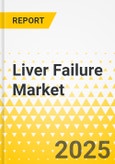This report comes with 10% free customization, enabling you to add data that meets your specific business needs.
The global liver failure market is experiencing steady growth, fuelled by increasing awareness of liver health, improved access to advanced healthcare facilities, and a growing range of therapeutic options. Liver transplantation remains the gold-standard treatment for end-stage liver failure, with outcomes improving due to advances in surgical techniques, organ preservation methods, and immunosuppressive therapy. In addition, innovations in supportive care, such as artificial liver support systems (ALSS) and extracorporeal bioartificial liver devices, are extending survival in patients awaiting transplants. The development of pharmacological therapies targeting specific etiologies, such as antiviral agents for hepatitis B and C, anti-fibrotic drugs for NAFLD, and immune-modulating therapies for autoimmune hepatitis, is expanding the treatment landscape. Furthermore, the integration of regenerative medicine approaches, including stem cell therapy and bioengineered liver tissues, holds promise for reducing transplant dependency in the future.
Treatment options for liver failure continue to diversify. In acute cases, rapid interventions such as N-acetylcysteine for acetaminophen toxicity or urgent antiviral therapy for acute hepatitis can prevent progression to complete liver shutdown. For chronic liver failure, management focuses on controlling the underlying cause, preventing complications such as portal hypertension, and improving liver function through medications, dietary interventions, and lifestyle changes. Emerging technologies in hepatocyte transplantation and tissue engineering are being explored to provide temporary or permanent liver function restoration without the need for a donor organ. The trend toward personalized medicine, tailoring therapy based on genetic, metabolic, and lifestyle factors, is also gaining momentum in the liver failure market.
Despite advancements, the liver failure market faces several challenges. The shortage of donor organs remains the most significant barrier, with demand far outstripping supply in many countries. High costs associated with transplantation, artificial liver devices, and long-term immunosuppressive therapy limit access, particularly in low- and middle-income regions. Limited awareness of early liver disease symptoms contributes to late-stage diagnosis, where treatment options are more limited and less effective. Additionally, the complexity of managing comorbidities such as diabetes, obesity, and cardiovascular disease complicates treatment and increases healthcare costs. In rural and resource-limited settings, the lack of specialized hepatology centers and trained transplant teams further constrains patient outcomes.
Key players in the liver failure market include major healthcare and pharmaceutical companies such as Gilead Sciences, Inc., AbbVie Inc., and Boehringer Ingelheim, alongside transplant technology providers and medical device companies developing artificial liver support systems. These stakeholders are investing heavily in R&D to improve transplant success rates, develop novel anti-fibrotic and anti-inflammatory drugs, and bring bioartificial liver technologies to market. Strategic collaborations between academic research centers, biotechnology firms, and public health agencies are accelerating innovation and expanding treatment access. Patient advocacy groups and non-profit organizations are also playing a growing role in raising awareness, improving organ donation rates, and funding liver disease research.
The competitive landscape is characterized by both established pharmaceutical leaders and emerging biotechnology startups pursuing novel therapeutic pathways, including gene therapy for inherited liver conditions, RNA-based treatments for metabolic liver diseases, and immunomodulatory drugs to prevent transplant rejection. As research into regenerative medicine, stem cell applications, and artificial organ development progresses, the market is expected to diversify, offering patients more tailored and potentially curative options. With continued investment in diagnostics, donor management, and next-generation treatment modalities, the global liver failure market is poised for sustained growth, improving survival rates and quality of life for patients worldwide.
The global liver failure market is growing steadily, propelled by rising prevalence of chronic liver diseases such as viral hepatitis, alcohol-associated liver disease, and NAFLD/NASH, sustained improvements in care pathways, and broader awareness of liver health. Advances in therapeutics and interventions ranging from potent antivirals and anti-fibrotic candidates to optimized transplant surgery, machine-perfusion organ preservation, and artificial/bioartificial liver support systems are reshaping the treatment landscape by extending survival and bridging more patients to transplant.The rise of personalized medicine using genomics, phenotyping, and AI-driven risk stratification to tailor etiology-specific regimens and post-transplant immunosuppression is opening the door to more patient-centric solutions. Expanding healthcare infrastructure and transplant capacity in emerging markets, alongside telehepatology and hub-and-spoke referral models, are increasing access to advanced care. As less invasive, more scalable diagnostics and supportive technologies become widely available, the liver failure market is positioned for continued expansion, underpinned by ongoing innovation across diagnostics, disease-modifying therapies, organ preservation, and patient management.
This product will be updated with the latest data at the time of order. Consequently, dispatch time for this product will be 7-10 business days.
Table of Contents
Companies Mentioned
- AbbVie Inc.
- Akero Pharmeceuticals
- Boehringer Ingelheim
- Gilead Sciences, Inc.
- Madrigal Pharmaceuticals
- Viking Therapeutics
- Zydus Pharmaceutical








